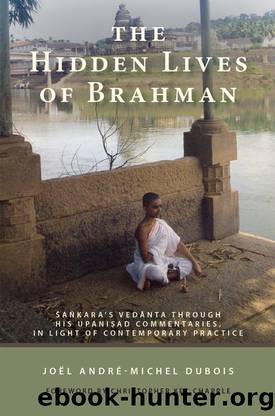The Hidden Lives of Brahman by Dubois Joël André-Michel & Christopher Key Chapple

Author:Dubois, Joël André-Michel & Christopher Key Chapple [Dubois]
Language: eng
Format: epub
ISBN: 9781438448077
Publisher: SUNY Press
Published: 2013-10-30T05:00:00+00:00
The syntax here resembles that used to convey the rice husking analogy of TUbh 2.2. Identical case endings and alliterative parallels underscore the simile between the divided-up (vyÄká¹tasya) world and the tree (vá¹ká¹£asya). The final statement, which once again interprets the intent of the upaniá¹£ad, underscores both conceptually and rhythmically that this saá¹sÄra-vá¹ká¹£aḥ (âtree of cycling [from birth to birth]â) is karma-bijo (âwhose seed is activityâ) and avidyÄ-ká¹£etro (âwhose field is blindnessâ). Åaá¹ kara here analytically discerns the root of saá¹sÄra and definitively urge its removal; what standard translations miss is the rhythmic juxtaposition of the three compounds, underscoring the persistent effort needed to uproot of the sprout of that vast world-tree from which the disenchanted person yearns to be released.
Immediately following the grammatical analysis of the pronouns âthat,â âthis,â and the verb âdivided-upâ in the upaniá¹£ad's first line, described in chapter 5, Åaá¹ kara adds another complementary, mutually restricting analogy that draws attention to the subtlety of (iii) brahman's connection to (iii) samsÄra, which links (i) avidyÄ to the concept of âname-and-shape.â (The (ii) disenchanted person is not explicitly mentioned in the above discussions, but his yearning for release is the implied impetus for discerning the precise relationship between avidyÄ, saá¹sÄra and brahman.) The logic of his statements are clear; but what standard translations once again miss is the structure of his syntax, which seems to mimic the five-fold diversity of the BU 1.4's own imagery. BU 1.4.7's next statementââhe who is this [primordial entity] entered26 here [into the body] up to the very nail tipsââimplicitly links the undivided entity (a-vyÄká¹tam), now divided simply by name-and-shape (nÄmarÅ«pÄbhyÄm eva) in the multiplicity of this world, to the vital presence within each embodied being. In transitioning to his gloss of this sentence, Åaá¹ kara strings together five clauses syntactically linked to the subject of the sentence, the pronoun sa (âheâ), which summarize the features of this abstract primordial entity. The number of parallel clauses here may mimic the five variations on the phrase âin the beginning this [world] wasâ¦,â which likewise all refer to the same primordial entity.
yad-arthaḥ sarva-ÅÄstrÄrambho
Download
This site does not store any files on its server. We only index and link to content provided by other sites. Please contact the content providers to delete copyright contents if any and email us, we'll remove relevant links or contents immediately.
| Chakras | Gandhi |
| History | Rituals & Practice |
| Sacred Writings | Sutras |
| Theology |
Fingersmith by Sarah Waters(2484)
Kundalini by Gopi Krishna(2138)
Wheels of Life by Anodea Judith(2098)
Indian Mythology by Devdutt Pattanaik(1901)
The Bhagavad Gita by Bibek Debroy(1900)
The Yoga of Jesus: Understanding the Hidden Teachings of the Gospels by Paramahansa Yogananda(1806)
Autobiography of a Yogi (Complete Edition) by Yogananda Paramahansa(1777)
The Man from the Egg by Sudha Murty(1746)
The Book of Secrets: 112 Meditations to Discover the Mystery Within by Osho(1632)
Chakra Mantra Magick by Kadmon Baal(1616)
The Sparsholt Affair by Alan Hollinghurst(1547)
Sparks of Divinity by B. K. S. Iyengar(1495)
Avatar of Night by Tal Brooke(1490)
Gandhi by Ramachandra Guha(1487)
Karma-Yoga and Bhakti-Yoga by Swami Vivekananda(1470)
The Bhagavad Gita (Classics of Indian Spirituality) by Eknath Easwaran(1453)
The Spiritual Teaching of Ramana Maharshi by Ramana Maharshi(1405)
Hinduism: A Very Short Introduction (Very Short Introductions) by Knott Kim(1347)
Skanda Purana (Great Epics of India: Puranas Book 13) by Bibek Debroy & Dipavali Debroy(1341)
